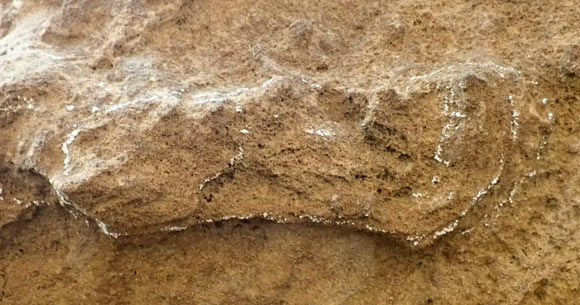153,000-Year-Old Homo sapiens Footprint Discovered in South Africa
The 153,000-year-old footprint, which was found in the Garden Route National Park, a national park in the Garden Route region of the South African Western Cape and Eastern Cape provinces, is the oldest footprint thus far attributed to our species, Homo sapiens.

The 153,000-year-old footprint, lightly ringed with chalk, in the Garden Route National Park, South Africa; it appears long and narrow because the trackmaker dragged their heel. Image credit: Charles Helm.
“Just over two decades ago, as the new millennium began, it seemed that tracks left by our ancient human ancestors dating back more than about 50,000 years were excessively rare,” Nelson Mandela University researcher Charles Helm and his colleagues told The Conversation.
“Only four sites had been reported in the whole of Africa at that time: Laetoli in Tanzania, Koobi Fora in Kenya, and Nahoon and Langebaan sites in South Africa.”
“Today, the African tally for dated hominin ichnosites — a term that includes both tracks and other traces — older than 50,000 years stands at 14.”
“These can conveniently be divided into an East African cluster (five sites) and a South African cluster from the Cape coast (nine sites).”
The researchers used a technique called optically stimulated luminescence to estimate the age of seven hominin ichnosites from the South African cluster on the Cape south coast.
“The Cape south coast is a great place to apply optically stimulated luminescence,” they explained.
“Firstly, the sediments are rich in quartz grains, which produce lots of luminescence.”
“Secondly, the abundant sunshine, wide beaches and ready wind transport of sand to form coastal dunes mean any pre-existing luminescence signals are fully removed prior to the burial event of interest, making for reliable age estimates.”
“This method has underpinned much of the dating of previous finds in the area.”

Incipient cementation in a Holocene dune near Still Bay, South Africa. Image credit: Helm et al., doi: 10.1080/10420940.2023.2204231.
They found that the South African ichnosites ranged in age; the most recent dates back about 71,000 years.
The oldest, which dates back 153,000 years, is one of the more remarkable finds recorded by the team.
It is the oldest footprint thus far attributed to anatomically modern Homo sapiens.
“There are significant differences between the East African and South African tracksite clusters,” the authors said.
“The East African sites are much older: Laetoli, the oldest, is 3.66 million years old and the youngest is 700,000 years old. The tracks were not made by Homo sapiens, but by earlier species such as australopithecines, Homo heidelbergensis and Homo erectus.”
“The South African sites on the Cape coast, by contrast, are substantially younger. All have been attributed to Homo sapiens.”
The team’s work was published in the Ichnos, an International Journal of Plant and Animal Traces.
Related Post
A shocking documentary proves that mermaids do exist
SHOCKING Revelation: Thuya, Mother of Queen Tiye, Was the Grandmother of Akhenaten and Tutankhamun—What Ancient Egyptian Secrets Did She Leave Behind?
Breaking News: Astonishing Discoveries at Karahan Tepe Confirm an Extraterrestrial Civilization is Hiding on Earth, and NO ONE Knows!
Breaking News: Researchers FINALLY Discover U.S. Navy Flight 19 After 75 Years Lost in the Bermuda Triangle!
NASA’s Secret Investigation: Uncovering the Astonishing Mystery of the UFO Crash on the Mountain!
Explosive UFO Docs LEAKED: Startling Proof That Aliens Ruled Ancient Egypt!